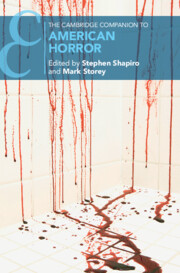Book contents
- The Cambridge Companion to American Horror
- The Cambridge Companion to American Horror
- Copyright page
- Contents
- Acknowledgments
- Contributors
- Introduction
- Part I Histories
- Part II Genres
- 7 Body Horror
- 8 Queer Horror
- 9 Folk Horror
- 10 Occult Horror
- 11 SF and the Weird
- 12 Monsters and Monstrosity
- Index
- Cambridge Companions To …
- References
7 - Body Horror
from Part II - Genres
Published online by Cambridge University Press: 21 July 2022
- The Cambridge Companion to American Horror
- The Cambridge Companion to American Horror
- Copyright page
- Contents
- Acknowledgments
- Contributors
- Introduction
- Part I Histories
- Part II Genres
- 7 Body Horror
- 8 Queer Horror
- 9 Folk Horror
- 10 Occult Horror
- 11 SF and the Weird
- 12 Monsters and Monstrosity
- Index
- Cambridge Companions To …
- References
Summary
Is all horror “body horror”? Can we think of the horror genre without thinking about the body’s messy and intimate materiality? This chapter looks at some of the queasier manifestations of horror culture, a mode that foregrounds questions of the body’s (and the reader’s or viewer’s) limits. Despite body horror’s association with recent cinema, this chapter argues for a longer and more diverse lineage for the term, an attention to embodied experience and its grotesque transformations that can be found in US fiction from Charles Brockden Brown’s spontaneous combustions in Wieland (1798) through to the zombie apocalypse novels of the twenty-first century. The emphasis is placed on five main types of body horror and their differences: hybrid corporeality, parasitism, abjection and disgust, the grotesque, and, finally, body horror built around gore and the explicit rendering of violence.
Keywords
- Type
- Chapter
- Information
- The Cambridge Companion to American Horror , pp. 107 - 119Publisher: Cambridge University PressPrint publication year: 2022

